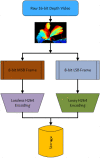MouseVUER: video based open-source system for laboratory mouse home-cage monitoring
- PMID: 38302573
- PMCID: PMC10834510
- DOI: 10.1038/s41598-024-52788-9
MouseVUER: video based open-source system for laboratory mouse home-cage monitoring
Abstract
Video monitoring of mice in the home-cage reveals behavior profiles without the disruptions caused by specialized test setups and makes it possible to quantify changes in behavior patterns continually over long time frames. Several commercial home-cage monitoring systems are available with varying costs and capabilities; however there are currently no open-source systems for home-cage monitoring. We present an open-source system for top-down video monitoring of research mice in a slightly modified home-cage. The system is designed for integration with Allentown NexGen ventilated racks and allows unobstructed view of up to three mice, but can also be operated outside the rack. The system has an easy to duplicate and assemble home-cage design along with a video acquisition solution. The system utilizes a depth video camera, and we demonstrate the robustness of depth video for home-cage mice monitoring. For researchers without access to Allentown NexGen ventilated racks, we provide designs and assembly instructions for a standalone non-ventilated rack solution that holds three systems for more compact and efficient housing. We make all the design files, along with detailed assembly and installation instructions, available on the project webpage ( https://github.com/NIH-CIT-OIR-SPIS/MouseVUER ).
© 2024. This is a U.S. Government work and not under copyright protection in the US; foreign copyright protection may apply.
Conflict of interest statement
The authors declare no competing interests.
Figures











Similar articles
-
SCORHE: a novel and practical approach to video monitoring of laboratory mice housed in vivarium cage racks.Behav Res Methods. 2015 Mar;47(1):235-50. doi: 10.3758/s13428-014-0451-5. Behav Res Methods. 2015. PMID: 24706080 Free PMC article.
-
Non-intrusive high throughput automated data collection from the home cage.Heliyon. 2019 Apr 4;5(4):e01454. doi: 10.1016/j.heliyon.2019.e01454. eCollection 2019 Apr. Heliyon. 2019. PMID: 30997429 Free PMC article.
-
Influence of Rack Design and Disease Prevalence on Detection of Rodent Pathogens in Exhaust Debris Samples from Individually Ventilated Caging Systems.J Am Assoc Lab Anim Sci. 2016 Nov;55(6):782-788. J Am Assoc Lab Anim Sci. 2016. PMID: 27931317 Free PMC article.
-
Microbiological monitoring in individually ventilated cage systems.Lab Anim (NY). 2004 Nov;33(10):36-41. doi: 10.1038/laban1104-36. Lab Anim (NY). 2004. PMID: 15514655 Free PMC article. Review.
-
A systematic review of the development and application of home cage monitoring in laboratory mice and rats.BMC Biol. 2023 Nov 13;21(1):256. doi: 10.1186/s12915-023-01751-7. BMC Biol. 2023. PMID: 37953247 Free PMC article.
Cited by
-
The MacqD deep-learning-based model for automatic detection of socially housed laboratory macaques.Sci Rep. 2025 Apr 7;15(1):11883. doi: 10.1038/s41598-025-95180-x. Sci Rep. 2025. PMID: 40195447 Free PMC article.
-
Accurate locomotor activity profiles of group-housed mice derived from home cage monitoring data.Front Neurosci. 2024 Sep 20;18:1456307. doi: 10.3389/fnins.2024.1456307. eCollection 2024. Front Neurosci. 2024. PMID: 39371613 Free PMC article.
References
MeSH terms
Grants and funding
LinkOut - more resources
Full Text Sources

